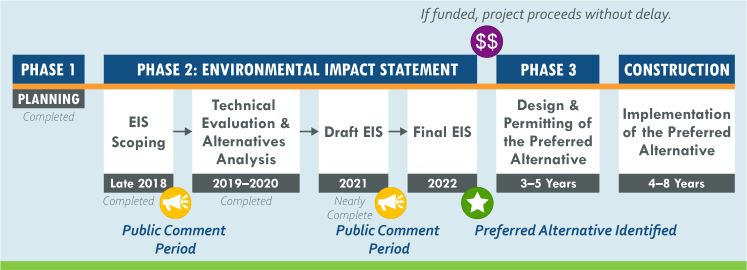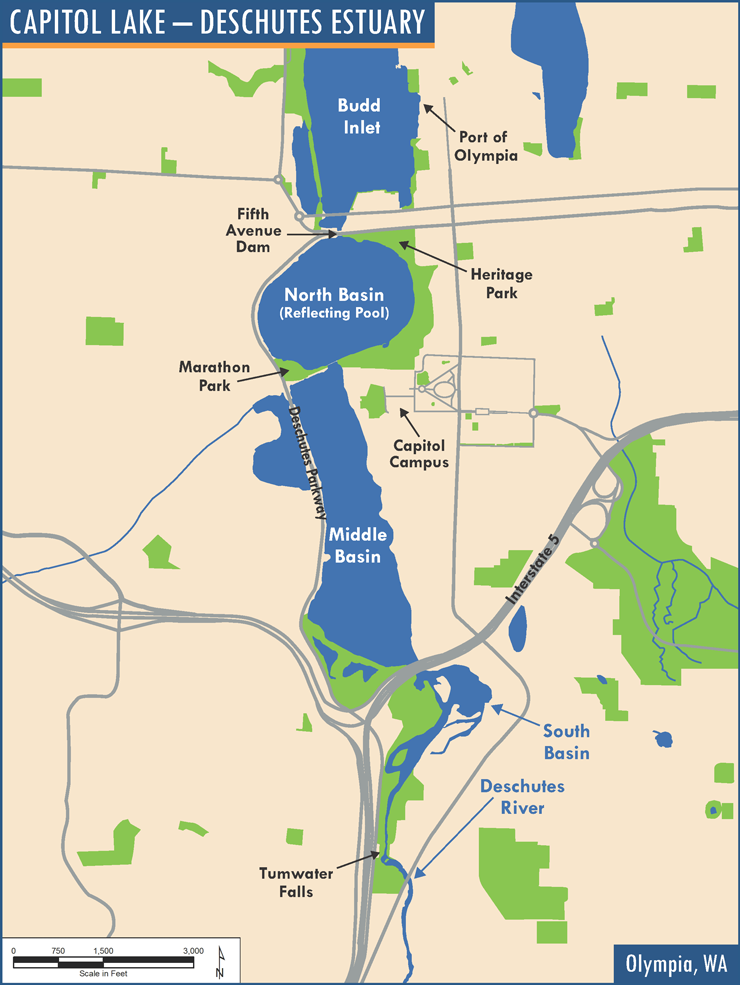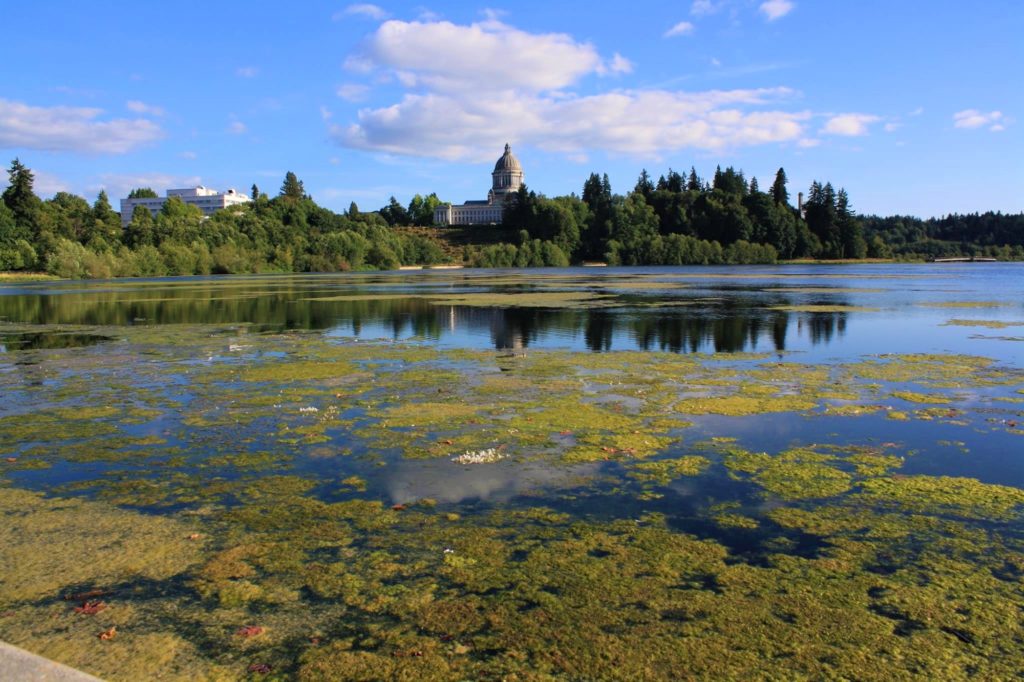The following information is taken directly from an email recently sent by the Department of Enterprise Services. To learn more about the EIS process or to sign-up to receive updates from DES, please visit this page: https://capitollakedeschutesestuaryeis.org
LOOK FOR THE DRAFT ENVIRONMENTAL IMPACT STATEMENT THIS SUMMER The EIS Project Team is finalizing a Draft Environmental Impact Statement (EIS) for the Capitol Lake – Deschutes Estuary Long-Term Management Project. Enterprise Services will issue the Draft EIS on June 30, 2021. This will start a 45-day public comment period (June 30 – August 13, 2021). Comments on the Draft EIS will be accepted through an online comment submission form, via email or mail, and at an online public hearing. The public comment period will also include a range of engagement activities, which are previewed below. Additional details on how to submit comments and participate in online events will be shared along with notification of the Draft EIS release. The EIS Project Team is busy conducting the range of technical analyses that will be summarized in the Draft EIS and will inform future selection of a preferred alternative for the Capitol Lake – Deschutes Estuary.

WHAT TO EXPECT IN THE DRAFT EIS
The Draft EIS will provide a description of the long-term management alternatives and an impartial discussion of significant environmental impacts and benefits, as well as mitigation measures that would avoid or minimize adverse impacts or enhance environmental quality. Neither short-term actions (e.g., dredging) nor construction of a long-term management alternative (Estuary, Hybrid, or Managed Lake) can be implemented without an EIS. The release of the Draft EIS marks a key milestone in the process to identify, and then implement, a long-term management alternative that will best achieve project goals.
The Draft EIS will include discussion of the following: Project Background and History
- Project Alternatives and Construction Approach
- Existing Conditions and Affected Environment
- Long-Term Impacts, Benefits, and Mitigation
- Short-Term Impacts and Mitigation
- Cumulative Effects
- Planning-Level Costs
- Funding and Governance, Work Groups, and Community Sounding Board
- Permits and Approvals for Implementation of a Preferred Alternative
For DERT, there is only one option: remove the 5th Ave Dam, reconnect the Deschutes River with South Sound, and restore 260 acres of valuable estuary habitat. We owe it the First People who have inhabited this space since time immemorial, we owe it to our children, we owe it to Mother Earth and all her inhabitants. How many studies will it take to acknowledge that the lake was a massive mistake?”
Background Info
The Capitol Lake – Deschutes Estuary includes the 260-acre Capitol Lake Basin, located on the Washington State Capitol Campus, in Olympia, Washington. This waterbody is an important recreational resource and valued amenity; however, it suffers from numerous environmental issues.

Water Quality Standard Violations
Capitol Lake is currently violating water quality standards because of high levels of phosphorus, which cause algae blooms that deplete dissolved oxygen in Capitol Lake and the adjacent Budd Inlet, using up oxygen essential for fish and other aquatic life.

Sediment Management Issues
Every year more than 35,000 cubic yards of sediment from the Deschutes River is deposited within the lake basins, resulting in increasingly shallow conditions. Today, the lake is about 21 percent smaller and it holds roughly 60 percent less water than it did in 1951.

Presence of Invasive Species
Fish and wildlife habitat are impacted due to the presence of several invasive and nuisance species including the New Zealand mudsnail, purple loosestrife, Eurasian watermilfoil, nutria, and Canada geese. These species out compete and negatively impact native populations.

Restricted Active Community Use
Over the years, high bacterial levels and the presence of invasive species have resulted in impacts to the recreational use of Capitol Lake. The presence of New Zealand mudsnails resulted in official closure to all active uses in 2009 and active use of the waterbody continues to be restricted today.
LONG-TERM MANAGEMENT STRATEGIES ARE NEEDED
In 2016, stakeholders, in collaboration with Washington State Department of Enterprise Services (Enterprise Services), identified common goals that should be satisfied by any long-term management alternative.
In 2018, Enterprise Services was directed by the State Legislature to develop an Environmental Impact Statement (EIS) that evaluates alternatives for long-term management. Enterprise Services is now preparing an EIS to document the potential environmental impacts of various alternatives and determine how these alternatives meet the long-term management objectives.
The EIS will evaluate and identify a preferred environmentally and economically sustainable long-term management alternative for the Capitol Lake – Deschutes Estuary Project.
What alternatives are being evaluated?
The State Legislature has required that Enterprise Services evaluate a Managed Lake, Estuary and Hybrid Alternative in the EIS. In an EIS, an analysis of the “No Action Alternative” is also required. The fundamental concepts for these four primary alternatives are summarized below. A measurable evaluation process was used to identify components of the alternatives that best meet project goals. Enterprise Services acknowledges that these alternatives may be modified, changed, or replaced during preparation of the EIS.





I’m hoping that the EIS will evaluate the risk associated with methane emissions from shallow lakes. Moving forward, the risk may increase, due to:
– Global warming,
– Shallower lake due to sentiment deposits (it’s already shrinking), and
– Lack of turnover/mixture in water layers of lake